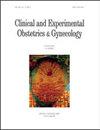A retrospective comparative analysis of systemic inflammatory response after laparoscopic, vaginal, and abdominal hysterectomy
IF 0.6
4区 医学
Q4 OBSTETRICS & GYNECOLOGY
引用次数: 1
Abstract
Background: Lymphocyte to neutrophil ratio (NLR) is a rapid and simple marker for systemic inflammation and stress after major surgery. In this study, we aimed to compare NLR changes according to surgical methods of hysterectomy. Methods: A retrospective chart review for all patients who underwent hysterectomy for benign uterine disease from 2016 to 2020 was performed. A total of 1549 women were assigned to total laparoscopic hysterectomy (TLH) (n = 419), vaginal hysterectomy (VH) (n = 608), and total abdominal hysterectomy (TAH) (n = 522) groups. Patient characteristics, surgical outcomes, and NLR changes were compared among women who underwent TLH, VH, and TAH. Results: Preoperative mean NLR was similar among three groups (p = 0.056). However, mean NLR on postoperative day 1 (p < 0.0001) and day 3 (p = 0.011) was significantly lower in TLH group than others. Also, mean NLR change on postoperative day 1 was significantly lesser in TLH group than others (1.9 in TLH vs. 5.4 in VH vs. 4.7 in TAH; p < 0.0001). Mean NLR change on postoperative day 3 was greater in TAH group than others, although there were no statistically significant differences (0.2 in TLH vs. 0.3 in VH vs. 0.7 in TAH; p = 0.354). Multivariate analysis revealed that massive NLR change (>5.0) on postoperative day 1 was significantly associated with types of hysterectomy (p < 0.0001). Conclusion: Our data showed that acute NLR change was lesser in TLH group comparing to VH and TAH group, which suggests that TLH might be associated with less systemic inflammation and tissue trauma after surgery.腹腔镜、阴道和腹部子宫切除术后全身炎症反应的回顾性比较分析
背景:淋巴细胞与中性粒细胞比率(NLR)是大手术后全身炎症和应激反应的一个快速而简单的标志物。在本研究中,我们旨在比较不同子宫切除术方法的NLR变化。方法:对2016年至2020年因良性子宫疾病接受子宫切除术的所有患者进行回顾性图表回顾。共有1549名女性被分为腹腔镜全子宫切除术(TLH)(n=419)、阴道全子宫切除手术(VH)(n=608)和腹式全子宫切除切除术(TAH)(n=522)组。比较了接受TLH、VH和TAH的女性的患者特征、手术结果和NLR变化。结果:三组术前平均NLR相似(p=0.056)。然而,TLH组术后第1天(p<0.0001)和第3天(p=0.011)的平均NLR显著低于其他组。此外,TLH组术后第1天的平均NLR变化明显小于其他组(TLH组1.9,VH组5.4,TAH组4.7;p<0.0001),尽管没有统计学上的显著差异(TLH为0.2,VH为0.3,TAH为0.7;p=0.354)。多因素分析显示,术后第1天NLR的巨大变化(>5.0)与子宫切除术类型显著相关(p<0.0001)。结论:我们的数据显示,与VH和TAH组相比,TLH组的急性NLR变化较小,这表明TLH可能与手术后较少的全身炎症和组织创伤有关。
本文章由计算机程序翻译,如有差异,请以英文原文为准。
求助全文
约1分钟内获得全文
求助全文
来源期刊
CiteScore
0.50
自引率
0.00%
发文量
241
审稿时长
1 months
期刊介绍:
CEOG is an international, peer-reviewed, open access journal. CEOG covers all aspects of Obstetrics and Gynecology, including obstetrics, prenatal diagnosis, maternal-fetal medicine, perinatology, general gynecology, gynecologic oncology, uro-gynecology, reproductive medicine, infertility, reproductive endocrinology, sexual medicine. All submissions of cutting-edge advances of medical research in the area of women''s health worldwide are encouraged.

 求助内容:
求助内容: 应助结果提醒方式:
应助结果提醒方式:


